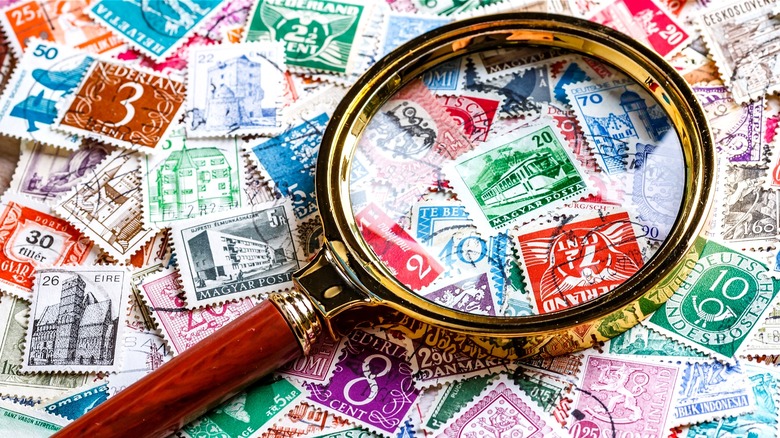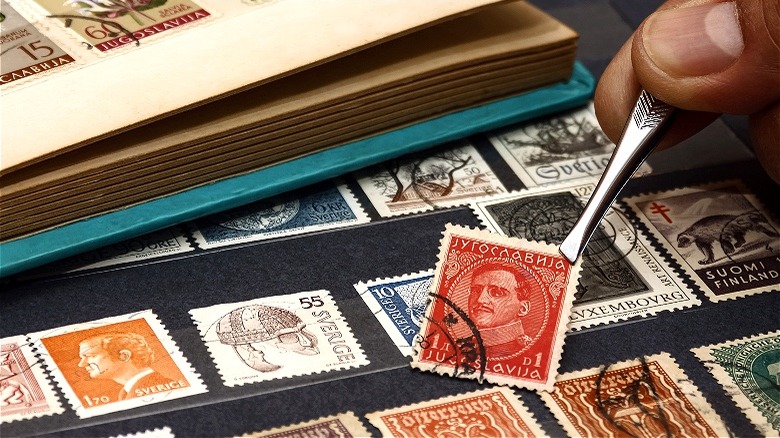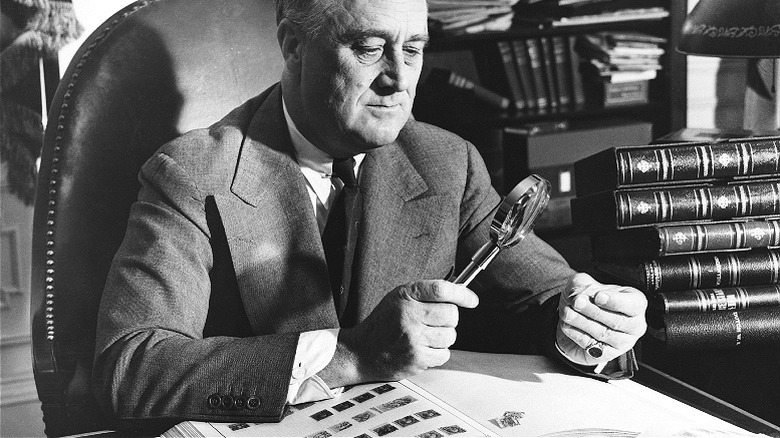The Unexpected Value Of Your Old Stamps Today
They say chess is the sport of kings, but King George V of Great Britain preferred stamps. He was quite serious about them, too. "I wish to have the best collection & not one of the best collections in England," he once wrote (per the Smithsonian National Postal Museum). His personal stamp albums are the foundation of Britain's Royal Philatelic Collection. And the king was far from the only person enthusiastic about the hobby. Since the birth of the modern postal service, stamp collecting has been a favorite pastime of many, including such notable names as Charlie Chaplin, John Lennon, and President Franklin Delano Roosevelt.
They, and King George, may well be upset if they knew that stamp collecting is on the decline as a hobby. Fewer and fewer young people are taking it up; the average age of a stamp collector is north of 60. In the digital age, physical mail and the stamps that go with them just aren't part of life in the same way anymore. The fun of hunting down rare stamps is also diminished by how plentiful they are. Even "commemorative" runs are over-issued. And it turns out many old stamps are still around in large quantities, so even if you come across, say, a great-grandparents' albums full of old stamps — in good condition — you're probably not going to get much, if anything, for them.
There are still valuable stamps out there
With stamps, as with nearly all collectibles, value is driven by scarcity; the rarer a given item in a series is, the more it's sought after and the more it's worth. (For example, these rare Pokémon cards are worth a ton of money today.) Because stamps are produced in such large quantities, however, and because so many of them are still around, there just aren't that many that can fetch high prices. This said, there are some stamps, ensconced in the pages of old albums or sitting forgotten in attics and storerooms, that are rare finds, and these can bring in a hefty sum.
A general rule of thumb is that stamps issued before 1930 will be worth more today, though that's still not a guarantee of fabulous riches if you opt to sell one. The price tag on old stamps can range anywhere from 25 cents for a 1-cent 1895 George Washington to $10,000 for a 90-cent 1857 stamp also featuring the first president. And there's always the odd one out that goes for much more than that. The famous "Inverted Jenny," a printing error in which an upside-down biplane appears on a 1918 commemorative stamp, set a record in 2023, selling for $2 million at auction. How rare is this stamp? Only a single sheet with 100 stamps was ever sold; all the rest were destroyed at the time.
But the high price tags connected to rare stamps may have more to do with one-upmanship among the super-rich than anything to do with the stamps themselves. Acquiring rare collectibles of any sort is an attractive status symbol for the wealthy across countries; it's the wealthy who can successfully go after prizes like the Inverted Jenny. (That being said, here are some common everyday habits of the world's wealthiest people.)
There's a grading system to collectible stamps
You might not have an Inverted Jenny stamp, or Elon Musk money, but you can still trade and sell old stamp collections and get some modest value out of it. If you do so, it helps to know a few things about how stamp collections are appraised. The age of the stamp is a factor, and, as said, rarity, but there are various other considerations that go into grading a stamp. (Speaking of which, read about the unexpected price of a Depression-era $10,000 bill.)
Other factors that can affect the grade and the value of a stamp include whether or not a stamp has been used, if there are any signs of wear and tear on the gum of the stamp, the quality of the stamp's color, and any tears or folds. The highest grade that can be given to a stamp is known as a "superb gem." This grade, and the next grade down of "superb," requires flawless gum on the stamp's back, perfect centering, and no defects of color. Below superb stamps are various grades of "fine," which are considered to be flawless in shape but with minor defects in gum or trace marks on the stamp face. The grading scale goes on like this, through various stages of "good" and finally to "poor."


